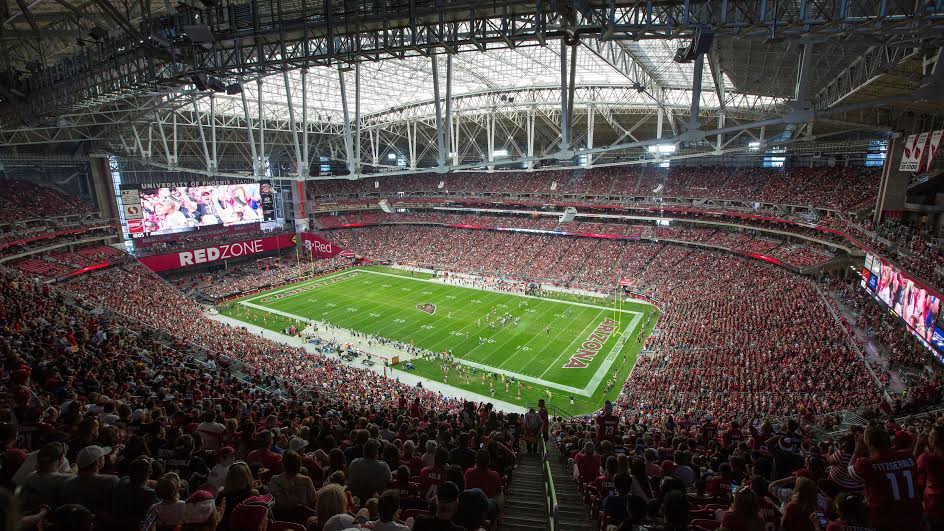For the first time ever the Super Bowl game last Sunday was lit by large LED lights. LED stands for light-emitting diode, lit by passing an electrical current through a semiconductive material in the bulb. The Super Bowl is an incredible opportunity for the NFL to demonstrate cutting edge technologies that have been implemented in the past season. The lights were recently installed at the University of Phoenix Stadium in Glendale, Arizona by Ephesus Lighting, and it only took 12 hours to install them! (1) The installation required switching 780 metal halide lights, previously the most efficient source of high-watt stadium lighting, with 312 Cree LED fixtures. Though other stadiums currently use LED lights, like Levi’s Stadium in San Francisco and NRG Stadium in Houston, Ephesus says that this is the first installation they have done of this size, and it is the first stadium to be lit entirely with LEDs. (2)
Ephesus’ president Mike Lorenz states that although the cost to buy and install LEDs is greater than for traditional lights, they cost much less to operate. According to the U.S. Energy Information Administration, the LED lighting costs about $47 per hour to light the field, compared to $186 per hour using halide bulbs. (3) Indeed, Ephesus estimates the switch to LEDs will reduce the stadium’s energy consumption from lighting from 1.24 million watts to just 310,000 watts, a decrease of 75%. (4) Peter Sullivan, general manager and regional vice president for Global Spectrum at the stadium said, “The Ephesus Lighting LED solution has improved lighting for the athletes, fans and broadcasters, all while reducing energy consumption and eliminating conventional sports lighting maintenance expenses.”
These fixtures are claimed not just to be more energy efficient, but to provide brighter and more uniform lighting than the metal halide lights they replace. This means better camera coverage for those watching and better accuracy when officials are watching slow-motion film. Even better, LED lights have the advantage of being able to be lit instantly, unlike metal halides which have a long warm up and turn-off period, which contributed to the lighting delays in Super Bowl XLVII in 2013. (5) Another advantage is that LED lights last longer, with a life of 100,000 hours, whereas metal halides need to be replaced every 3,000 hours. (6)
Importantly, these lights represent a fantastic implementation of location-appropriate green technology, as Arizona has historically been very supportive of solar electricity generation, but less so of recycling initiatives, due to lack of economic pressure. There, it’s simply cheaper to use a landfill and produce more raw materials than it is to recycle.
It is important to note that just a few years ago this type of lighting was likely too costly for teams to invest in, but that is changing as teams realize that maintenance and electricity costs can be reduced by installing LEDs. According to Ephesus, the return-on-investment time for an indoor facility is about two years. For outdoor stadiums, Ephesus intends to show that they can reduce maintenance costs, and even though LED lights are still more expensive, the installation is relatively easy and very quick.
Next year’s Super Bowl, slated to be held in San Francisco, stands to be the most environmentally friendly to date. In a recent interview, Keith Bruce, CEO of the host committee, outlined the ways by which they plan to reach that benchmark. He stated that the committee was concentrating efforts on responsible use of materials, as well as education of attendees, representing a change from the ideas applied at this year’s event.
With over 100 million people watching, San Francisco has the potential to educate many, and to have minimal local impact on the environment, too.
If you’re wondering what LED lights are, how they work, and why they are more energy efficient, visit the Energy Star website to learn more.
Here’s a guide to finding the best and most energy efficient bulb for you at home!
(1) “Syracuse Startup Brightens First-Ever Super Bowl Through LED Lights”. January 30, 2015. Sporttechie.com. Accessed January 30, 2015. http://www.sporttechie.com/2015/01/30/syracuse-startup-brightens-first-ever-super-bowl-led-lights/
(2) “Upcoming Super Bowl will the be first to be lit with energy-efficiend LED lights”. January 30, 2015. eia.gov. Accessed January 30, 2015. http://www.eia.gov/todayinenergy/detail.cfm?id=19791
(3) “Super Bowl 2015 will be first to take place under energy-efficient LED lights” January 30, 2015. CBSnews.com. Accessed January 30, 2015. http://www.cbsnews.com/news/super-bowl-2015-will-be-first-to-take-place-under-energy-efficient-led-lights/
(4) “LED lighting makes its Super Bowl debut” January 30, 2015. Cnet.com. Accessed January 30, 2015. http://www.cnet.com/news/led-lighting-makes-its-super-bowl-debut/
(5) “LED lighting makes its Super Bowl debut” January 30, 2015. Cnet.com. Accessed January 30, 2015. http://www.cnet.com/news/led-lighting-makes-its-super-bowl-debut/
(6) “Seattle Mariners become first MLB team to install LED stadium lights”. January 20, 2015. geekwire.com. Accessed January 30, 2015. http://www.geekwire.com/2015/photos-seattle-mariners-become-first-mlb-team-install-led-lights/
(7) “LED Lighting Makes Pro, Trains For Super Bowl Debut” January 27, 2015. Forbes.com. Accessed January 30, 2015. http://www.forbes.com/sites/heatherclancy/2015/01/27/led-lighting-makes-pro-trains-for-super-bowl-debut/


